| ||||||||
| ||||||||
Medical Center
Acupuncture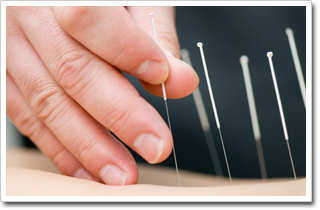 Acupuncture is a therapeutic intervention that inserts fine, sterilized needles into certain areas of the body. The points that are needled are selected according to differential diagnosis, presenting symptoms, and channel theory in order to achieve a homeostatic response, improve blood circulation, stimulate physiology, reduce swelling, and remedy patterns of illness and pain. We use a variety of acupuncture techniques that best adapt to our patient’s condition. Most patients find acupuncture to be a relaxing experience where their own sensations of relaxation, increased circulation, and rest far outweigh the occasional small prick from the needles. Acupuncture is a therapeutic intervention that inserts fine, sterilized needles into certain areas of the body. The points that are needled are selected according to differential diagnosis, presenting symptoms, and channel theory in order to achieve a homeostatic response, improve blood circulation, stimulate physiology, reduce swelling, and remedy patterns of illness and pain. We use a variety of acupuncture techniques that best adapt to our patient’s condition. Most patients find acupuncture to be a relaxing experience where their own sensations of relaxation, increased circulation, and rest far outweigh the occasional small prick from the needles.
The needles are sterile and used only once. Acupuncture needles are not serrated like a hypodermic needle is. Therefore, they do not cut their way into the body as a hypodermic needle does and there is little discomfort with acupuncture.
Acupotomology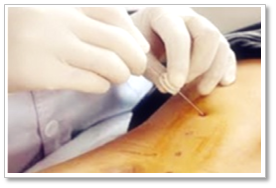 Acupotomology, a fusion of the basic theories of traditional Chinese and modern western medicine, has formed a complete system of medical science. This is a revolution in the medical field. Moreover, it symbolizes a new era in the medical science.
Based on the completely new theory and outstanding curative effect, acupotomology and acupotomy have extensively been accepted by numerous patients . Acupotomology, a fusion of the basic theories of traditional Chinese and modern western medicine, has formed a complete system of medical science. This is a revolution in the medical field. Moreover, it symbolizes a new era in the medical science.
Based on the completely new theory and outstanding curative effect, acupotomology and acupotomy have extensively been accepted by numerous patients .
Acupotomology has reached a state of "ECCE" ---- EASY, CONVINIENT, CHEAP and EFFECTIVE. Under the guidance of these innovative theories,acupotomology has developed a complete set of standards for diagnosis and treatment. They help to precisely diagnose and treat disease. With the application of the theory concerning closed surgery,acupotomology can now perform closed surgeries on diseases where only open surgeries were feasible. The special apparatus in acupotomy - needle and scalpel. Acupotomology has its unique manipulation. Its four- steps, eight-ways manipulation and eleven enter ways of closed surgery ensure safety and efficiency of the surgeries. The therapy of acupotomology is combined with special follow-up manipulations when necessary. Such manipulations are different from traditional ones. New theoretical bases make the treatment more scientific, efficient and labor - saving. Patients can undergo acupotomological therapy repeatedly and continuosly even within a short period of time. Patients are freed from sequelas or complications.
Acupressure or Tuina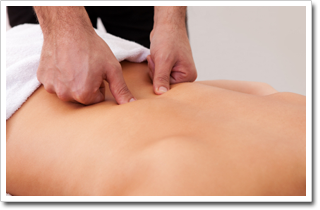 Tuina means to "push and pull". It is a complete system of Chinese bodywork that can be used to treat internal or external conditions. It is much more detailed than acupressure or massage because it utilizes many different manual techniques that correspond to the meridians, anatomy, Chinese medical theory, specific disease conditions, and remedial applications. Tuina means to "push and pull". It is a complete system of Chinese bodywork that can be used to treat internal or external conditions. It is much more detailed than acupressure or massage because it utilizes many different manual techniques that correspond to the meridians, anatomy, Chinese medical theory, specific disease conditions, and remedial applications.
Tuina has no pharmaceutical side effects like modern drug-based and chemical-based treatments. It is safe and manageable at any setting practiced by well-trained professionals. It has been widely utillized to treat or complement the treatment of many conditions, including musculoskeletal disorders and chronic stress-related disorders of the digestive, respiratory, and reproductive systems.
Cupping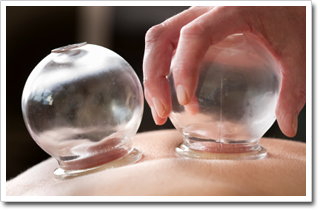 Cupping is a technique in Traditional Chinese Medicine of treating ailments that are brought about by localized blockage such as common colds, stomach aches, headaches, abdominal pains, indigestion, low back pain, hypertension and arthritis. Practitioners of TCM know that the method of cupping is excellent in promoting good blood and energy circulation. Cupping is a technique in Traditional Chinese Medicine of treating ailments that are brought about by localized blockage such as common colds, stomach aches, headaches, abdominal pains, indigestion, low back pain, hypertension and arthritis. Practitioners of TCM know that the method of cupping is excellent in promoting good blood and energy circulation.
Cupping method is done by applying inverted cups with heated air inside on certain parts of the body to create a vacuum. The heat inside the cup allows it to stick to the skin and pull it upward. The heated cups also provide a stimulating effect. When the cupping jar draws up the underlying tissue, blood stasis will form and the cupped area will appear bruised. It is said the darker the area gets, the more stagnant the blood is in that area and the more toxins are released. While cupping normally results to bruising and some swelling, the actual session is not painful. As for the bruises, they are minor, harmless and will disappear in a few days.
Gua Sha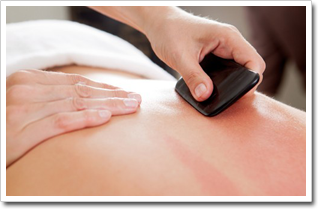 Gua Sha is an ancient therapy practiced in traditional Chinese medicine that is used to relieve the stagnation of blood that obstructs surface tissues and inhibits organ function. The meaning of the Chinese character “Gua” is to rub or to scrape while the second character “Sha” means a reddish and raised area of skin. Literally in Chinese "Gua Sha" means "to scrape away fever". Gua Sha is an ancient therapy practiced in traditional Chinese medicine that is used to relieve the stagnation of blood that obstructs surface tissues and inhibits organ function. The meaning of the Chinese character “Gua” is to rub or to scrape while the second character “Sha” means a reddish and raised area of skin. Literally in Chinese "Gua Sha" means "to scrape away fever".
The Gua Sha technique facilitates healing of the body by pressing or “scraping” the skin repeatedly with certain blunt, rounded tools such as a soup spoon, a slice of jade or a coin. Special therapy oil is applied on the skin first before it is scraped so the client does not feel any pain during the therapy. The strokes are repeated until the Sha appears, resulting in the appearance of red, elevated patches on the treated area. Likewise, the client shouldn’t feel any pain after the session. Gua Sha will not damage the skin and the Sha rashes or bumps should be gone within two to four days. If the Sha takes longer to fade, it means the client has poor blood flow and is likely to have either a blood or Qi deficiency or an underlying organ deficiency.
Moxibustion Moxibustion is a modality that utilizes a dried, refined herbal floss that, when smoldering, provides penetrating warm to a specified area. Moxibustion can be used to improve circulation, disperse various pathological conditions, and stimulate body functions. Moxibustion is a modality that utilizes a dried, refined herbal floss that, when smoldering, provides penetrating warm to a specified area. Moxibustion can be used to improve circulation, disperse various pathological conditions, and stimulate body functions.
We primarily use small hand-rolled moxa cones that are ignited by a small lit incense stick. Usually we do not let the smoldering material touch the skin and extinguish immediately once there is a hot sensation.
Chinese Herbal Treatment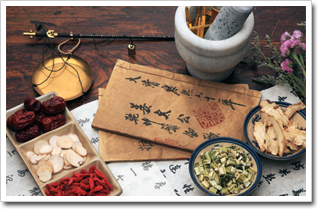 Traditional Chinese herbal formulas offer a medicinal-based approach to healthcare using naturally occurring ingredients that are carefully prescribed according to individualized diagnosis. Chinese herbs are most commonly dispensed in multi-ingredient prescriptions that often include seven to twelve different medicinals combined to treat a pattern of illness. Traditionally bulk medicinals are packaged in formula doses for the patient to take home, prepare, and consume. Recently, these formulas and medicinals are commonly manufactured into granule products. Therefore, it is common for clinics to dispense modern herbal extract granules to their patients instead of the bulk material. We feel that for many of the cases, granules are sufficed. However, time and again, bulk medicinals are more appropriate. Traditional Chinese herbal formulas offer a medicinal-based approach to healthcare using naturally occurring ingredients that are carefully prescribed according to individualized diagnosis. Chinese herbs are most commonly dispensed in multi-ingredient prescriptions that often include seven to twelve different medicinals combined to treat a pattern of illness. Traditionally bulk medicinals are packaged in formula doses for the patient to take home, prepare, and consume. Recently, these formulas and medicinals are commonly manufactured into granule products. Therefore, it is common for clinics to dispense modern herbal extract granules to their patients instead of the bulk material. We feel that for many of the cases, granules are sufficed. However, time and again, bulk medicinals are more appropriate.
Chinese herbs may be used for internal consumption and for external applications alike. The formulas, however; will differ between the two methods therefore specific instructions need to be followed. | ||||||||
|
Home |
About us |
Founder |
Recognition |
Academy |
Orthopedic |
Medical Center |
Gallery |
Inquiry |
Contact Us
Copyright © Ji Ting Academy of TCM | ||||||||





